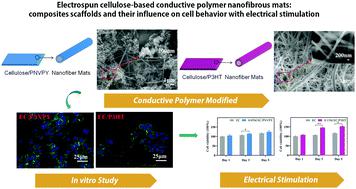当前位置:
X-MOL 学术
›
Soft Matter
›
论文详情
Our official English website, www.x-mol.net, welcomes your
feedback! (Note: you will need to create a separate account there.)
Electrospun cellulose-based conductive polymer nanofibrous mats: composite scaffolds and their influence on cell behavior with electrical stimulation for nerve tissue engineering.
Soft Matter ( IF 2.9 ) Pub Date : 2020-06-04 , DOI: 10.1039/d0sm00593b Fangwen Zha 1 , Wei Chen 2 , Lu Hao 1 , Chunsheng Wu 2 , Meng Lu 2 , Lifeng Zhang 3 , Demei Yu 1
Soft Matter ( IF 2.9 ) Pub Date : 2020-06-04 , DOI: 10.1039/d0sm00593b Fangwen Zha 1 , Wei Chen 2 , Lu Hao 1 , Chunsheng Wu 2 , Meng Lu 2 , Lifeng Zhang 3 , Demei Yu 1
Affiliation

|
The fabrication of scaffolds with suitable chemical, physical, and electrical properties is critical for nerve cell adhesion and proliferation. Recently, electrical stimulation on conductive polymers has been applied to construct functional nerve cell scaffolds. Herein, we prepared natural polymer (cellulose)/conductive polymer nanofibrous mats, i.e., electrospun cellulose (EC)/poly N-vinylpyrrole (PNVPY) and EC/poly(3-hexylthiophene) (P3HT) through an efficient in situ polymerization method. The surface immobilization was characterized by optical microscopy (OM), scanning electron microscopy (SEM), Fourier transform infrared (FTIR) spectroscopy, hydrophilicity, porosity, and cyclic voltammetry. The OM and SEM images showed that PNVPY formed polymer coatings and aggregated nanoparticles on the EC nanofibers, while P3HT only produced polymer coatings. Compared with pure EC mats, both the composite mats had increased thickness, higher porosity, and higher conductivity. Also, an increase in hydrophilicity was found for EC/P3HT. In vivo cytocompatibility of the undifferentiated PC12 cells showed that the EC/PNVPY and EC/P3HT scaffolds exhibited favorable cell activity, adhesion, and proliferation. Furthermore, the results of electrical stimulation experiments indicated that the EC/P3HT mats could effectively promote the proliferation of the PC12 cells more than the EC and EC/PNVPY mats. The findings suggest a positive outcome regarding the conductive polymer-modified EC/PNVPY and EC/P3HT nanofibrous mats in neural tissue engineering.
中文翻译:

电纺纤维素基导电聚合物纳米纤维垫:复合支架及其对神经组织工程的电刺激对细胞行为的影响。
具有合适的化学,物理和电学性质的支架的制造对于神经细胞的粘附和增殖至关重要。最近,对导电聚合物的电刺激已被用于构建功能性神经细胞支架。在这里,我们通过高效的原位制备了天然聚合物(纤维素)/导电聚合物纳米纤维垫,即静电纺丝纤维素(EC)/聚N-乙烯基吡咯(PNVPY)和EC /聚(3-己基噻吩)(P3HT)。聚合方法。通过光学显微镜(OM),扫描电子显微镜(SEM),傅里叶变换红外(FTIR)光谱,亲水性,孔隙率和循环伏安法对表面固定化进行了表征。OM和SEM图像显示PNVPY在EC纳米纤维上形成聚合物涂层并聚集纳米颗粒,而P3HT仅产生聚合物涂层。与纯EC垫相比,两种复合垫都具有增加的厚度,更高的孔隙率和更高的导电性。另外,发现EC / P3HT的亲水性增加。体内未分化的PC12细胞的细胞相容性表明EC / PNVPY和EC / P3HT支架表现出良好的细胞活性,粘附和增殖。此外,电刺激实验的结果表明,EC / P3HT垫比EC和EC / PNVPY垫能更有效地促进PC12细胞的增殖。这些发现表明在神经组织工程中有关导电聚合物改性的EC / PNVPY和EC / P3HT纳米纤维垫的积极成果。
更新日期:2020-07-22
中文翻译:

电纺纤维素基导电聚合物纳米纤维垫:复合支架及其对神经组织工程的电刺激对细胞行为的影响。
具有合适的化学,物理和电学性质的支架的制造对于神经细胞的粘附和增殖至关重要。最近,对导电聚合物的电刺激已被用于构建功能性神经细胞支架。在这里,我们通过高效的原位制备了天然聚合物(纤维素)/导电聚合物纳米纤维垫,即静电纺丝纤维素(EC)/聚N-乙烯基吡咯(PNVPY)和EC /聚(3-己基噻吩)(P3HT)。聚合方法。通过光学显微镜(OM),扫描电子显微镜(SEM),傅里叶变换红外(FTIR)光谱,亲水性,孔隙率和循环伏安法对表面固定化进行了表征。OM和SEM图像显示PNVPY在EC纳米纤维上形成聚合物涂层并聚集纳米颗粒,而P3HT仅产生聚合物涂层。与纯EC垫相比,两种复合垫都具有增加的厚度,更高的孔隙率和更高的导电性。另外,发现EC / P3HT的亲水性增加。体内未分化的PC12细胞的细胞相容性表明EC / PNVPY和EC / P3HT支架表现出良好的细胞活性,粘附和增殖。此外,电刺激实验的结果表明,EC / P3HT垫比EC和EC / PNVPY垫能更有效地促进PC12细胞的增殖。这些发现表明在神经组织工程中有关导电聚合物改性的EC / PNVPY和EC / P3HT纳米纤维垫的积极成果。











































 京公网安备 11010802027423号
京公网安备 11010802027423号